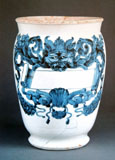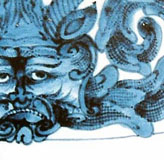- Museum Accession No.: EA1998.28
- Catalogue No.: 9
- Object type: Jar
- Kiln/Location: Blue-and-white, Arita
- Period/Date: early to mid-17th century
- Dimensions: H. 26.5 cm
- Provenance: Story Fund
- Description: Jar. Western albarello drug-jar shape with everted lip and spreading foot. Painted on one side with satyrs head, floral scrolls, swags and a shell surrounding an empty label.
No prototype for the distinctive decorative label has been found in Dutch earthenware. The closest comparisons seem to lie within the Portuguese earthenwares (see Impey, 2001) where similar masks are to be found. This raises the possibility that the Portuguese in Japan were using Japanese porcelain before 1639, the year of their final expulsion. The Portuguese purchased and ordered quantities of Japanese lacquerware both for use within Japan and for exportation, and they were well informed about local products. It is therefore unlikely that they were unaware of the relatively new Japanese porcelain industry in Arita. It would seem logical for the Portuguese to exploit local sources of supply for items such as those necessary for their apothecaries and surgeons' shops in Japan, just as the Dutch were to do later. If this is so, and it is undocumented, then this jar, and the one or two similar ones known, would have to date to the late 1630s, at the latest, and be the first porcelains made in Japan to Western demand in Western shape. Sherds of albarelli based on Dutch prototypes have been found at Sarugawa and Shimoshirakawa kiln-sites, but these bear almost no resemblance to the present piece; for a complete example, see no. 446 under Recent Acquisitions. For sherds, see Impey, 1996, fig. 93. Some white Japanese porcelain albarelli were found in the wreck of the Oosterland, a VOC ship wrecked at the Salt River Mouth, South Africa, in 1697. These were in a variety of shapes and sizes, not much resembling the present piece in shape, having more affinity with the two Dutch-decorated albarelli in the Groninger Museum, Groningen (see Jorg, 2003, nos. 269, 270). For the ceramics found in the Oosterland wreck, see Werz and Klose, 1994; for a brief account of the wreck, see Sotheby's, South Africa, catalogue 27 May 1997, pp. 24, 25 and lot 129.
- Exhibited: Porcelain for Palaces, 1990, no. 30 Published: Impey and MacGregor, 1985, fig. 105; Impey, 2001
- Similar Example: Porcelain for Palaces, 1990, no. 30 Published: Impey and MacGregor, 1985, fig. 105; Impey, 2001
- Illustrated:
|
Main View
|




